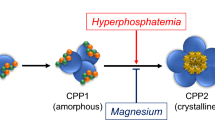Abstract.
In adults, advanced glycation end products (AGEs) rise slowly in tissues and circulation during aging, and accumulate at an accelerated rate both in diabetes and chronic renal insufficiency (CRI). We aimed to investigate the pattern of AGE accumulation in children/adolescents with CRI and on renal replacement therapy by dialysis and transplantation. Concentrations of fluorescent AGEs, carboxymethyllysine (CML) and lipofuscin-like substance (LFLS, a marker of lipid peroxidation) were followed. Data were obtained from 11 CRI patients on conservative treatment (age 12.6±1.7 years, serum creatinine: 205.7±17.5 µmol/l), ten patients on renal replacement therapy with dialysis (13.6±1.7 years, 698.2±48.9 µmol/l) and nine patients after kidney transplantation (15.9±1.1 years, 115.9±12.0 µmol/l) and comparison made with the data from 28 healthy controls (11.8±8.2 years, 44.1±8.2 µmol/l). In controls, an age-dependent rise of fluorescent AGE and CML levels was observed. In the CRI group, fluorescent AGEs [0.38±0.03×105 arbitrary units (AU)] and CML (369±26 ng/ml) concentrations were doubled compared with controls (0.16±0.03×105 AU and 189±42 ng/ml, respectively) and even higher levels were revealed in dialyzed patients (0.80±0.05×105 AU; 650±94 ng/ml). Successful kidney transplantation significantly reduced but did not normalize fluorescent AGE levels (0.39±0.03 ×105 AU), while the decline in CML levels (550±47 ng/ml) was insignificant. Plasma LFLS was elevated in CRI (19.6± 1.7 AU) and was even higher in dialyzed children (32.0±5.3 AU) compared with healthy controls (7.1± 1.4 AU). Kidney transplantation did not normalize LFLS levels (20.3±5.3 AU), pointing to persistently enhanced lipid peroxidation. Our study provides the first data on enhanced fluorescent AGEs and CML levels in children/adolescents with CRI and on dialysis. Successful renal transplantation decreased but did not normalize AGE levels, probably because of still-impaired renal function with enhanced oxidative stress, as well as the influence of immunosuppressive therapy.
Similar content being viewed by others
Author information
Authors and Affiliations
Additional information
Received: 13 July 2000 / Revised: 8 June 2001 / Accepted: 12 July 2001
Rights and permissions
About this article
Cite this article
Šebeková, K., Podracká, Ł., Blažíček, P. et al. Plasma levels of advanced glycation end products in children with renal disease. Pediatr Nephrol 16, 1105–1112 (2001). https://doi.org/10.1007/s004670100038
Issue Date:
DOI: https://doi.org/10.1007/s004670100038




